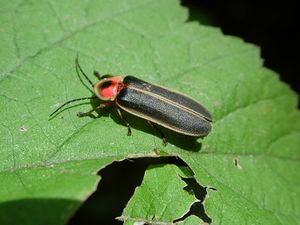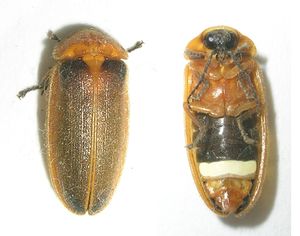يراعة
| يراعة | |
|---|---|
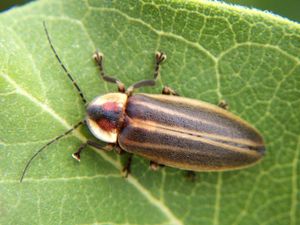
| |
| Photuris lucicrescens[1] | |
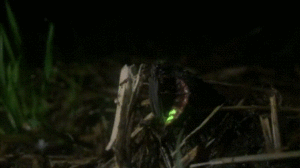
| |
| Lampyris noctiluca mating | |
| التصنيف العلمي | |
| مملكة: | |
| Phylum: | |
| Class: | |
| Order: | |
| Suborder: | |
| Infraorder: | |
| Superfamily: | |
| Family: | Lampyridae لاتريل، 1817
|
| تحت فصائل | |
|
Cyphonocerinae الأجناس incertae sedis: | |
اليراعة أو الخنافس المضيئة أو الحباحب إنگليزية: Fireflies أو Lightning bugs حشرة تنتمي إلى أسرة الخنافس غمدية الأجنحة، من رتيبة بوليفاجا. تتميز بظاهرة الإضاءة الباردة. They are soft-bodied beetles commonly called fireflies, lightning bugs, or glowworms for their conspicuous production of light, mainly during twilight, to attract mates. Light production in the Lampyridae is thought to have originated as an honest warning signal that the larvae were distasteful; this was co-opted as a mating signal in the adults. In a further development, female fireflies of the genus Photuris mimic the flash pattern of Photinus species to trap their males as prey.
Fireflies are found in temperate and tropical climates. Many live in marshes or in wet, wooded areas where their larvae have abundant sources of food. While all known fireflies glow as larvae, only some species produce light in their adult stage, and the location of the light organ varies among species and between sexes of the same species. Fireflies have attracted human attention since classical antiquity; their presence has been taken to signify a wide variety of conditions in different cultures and is especially appreciated aesthetically in Japan, where parks are set aside for this specific purpose.
علم الأحياء
Fireflies are beetles and in many aspects resemble other beetles at all stages of their life cycle, undergoing complete metamorphosis.[2] A few days after mating, a female lays her fertilized eggs on or just below the surface of the ground. The eggs hatch three to four weeks later.[3] In certain firefly species with aquatic larvae, such as Aquatica leii, the female oviposits on emergent portions of aquatic plants, and the larvae descend into the water after hatching.[4]
The larvae feed until the end of the summer. Most fireflies hibernate as larvae. Some do this by burrowing underground, while others find places on or under the bark of trees. They emerge in the spring. At least one species, Ellychnia corrusca, overwinters as an adult.[5] The larvae of most species are specialized predators and feed on other larvae, terrestrial snails, and slugs. Some are so specialized that they have grooved mandibles that deliver digestive fluids directly to their prey. The larval stage lasts from several weeks up to, in certain species, two or more years.[6] The larvae pupate for one to two and a half weeks and emerge as adults.[3]
Adult diet varies among firefly species: some are predatory, while others feed on plant pollen or nectar. Some adults, like the European glow-worm, have no mouth, emerging only to mate and lay eggs before dying. In most species, adults live for a few weeks in summer.[3][7]
Fireflies vary widely in their general appearance, with differences in color, shape, size, and features such as antennae. Adults differ in size depending on the species, with the largest up to 25 mm (1 in) long. Many species have non-flying larviform females. These can often be distinguished from the larvae only because the adult females have compound eyes, unlike the simple eyes of larvae, though the females have much smaller (and often highly regressed) eyes than those of their males.[8] The most commonly known fireflies are nocturnal, although numerous species are diurnal and usually not luminescent; however, some species that remain in shadowy areas may produce light.[2]
Most fireflies are distasteful to vertebrate predators, as they contain the steroid pyrones lucibufagins, similar to the cardiotonic bufadienolides found in some poisonous toads.[9] All fireflies glow as larvae, where bioluminescence is an honest aposematic warning signal to predators.[10][11][12]
يتركب جسم الخنافس المضيئة من ثلاث مناطق هي:
- -الرأس: وهى المنطقة الأمامية من الجسم ويحمل الرأس زوجين من الأعين المركبة وزوجًا من قرون الاستشعار وكذلك أجزاء الفم القارضة والتي تستخدمها الخنافس وكذلك يرقاتها في افتراس الحشرات الأخرى الصغيرة وافتراس البزاقات والقواقع وديدان الأرض.
- -الصدر: عبارة عن ثلاث حلقات وتحمل كل حلقة زوج من أرجل المشي وتحمل الحلقة الثانية والثالثة زوجين من الأجنحة. وبعض الأنواع نجدها غير مجنحة.
- -البطن: وهي المنطقة الأخيرة من الجسم وتتكون من 11 حلقة
الضوء والإنتاج الكيمائي
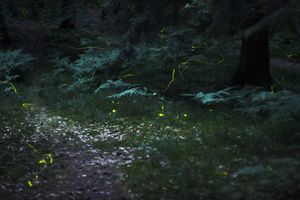
توجد هذه المركبات الكيميائية في الخنافس المضيئة على جانبي السطح البطني لمنطقة البطن عدد من الخلايا تسمى الخلايا الضوئية (Photocytes) وهذه الخلايا غالبا ما توجد في الحلقات الأخيرة من البطن سواء للأطوار الكاملة أو يرقاتها. وتتوقف كمية الضوء المنبعثة من الخنافس على كمية الأكسجين الداخلة في التفاعل فعندما تريد الخنافس إنتاج وميض طويل لفترة طويلة فإن المخ يعطى تياراً عصبياً إلى نهايات الجهاز التنفسي لإنتاج كمية كبيرة من الأكسجين إلى داخل الخلايا الضوئية فيصدر ضوء بكمية كبيرة. وفي بعض الأنواع تصدر الخنافس وميض متقطع وفي هذه الحالة يتوقف التيار العصبي لثواني فيتوقف الوميض ثم يحدث التيار العصبي مرة أخرى ويصدر الضوء من جديد.
إن الضوء الصادر من الخنافس المضيئة يسمى الضوء البارد، عند تحليل العلماء لهذا الضوء وجدوا أنه عبارة عن 100% طاقة ضوئية وصفر% حرارة، حيث أن هذا الضوء لو كان به نسبة حرارة ولو بسيطة لاحترق جسم الخنفساء ودمرت.
هذه الخنافس تتواجد في بيئة قاسية ذات حرارة مرتفعة جدّاً فلهذا تلجأ إلى النشاط والبحث عن الغذاء ليلاً. لكي ترى بعضها وسط الغابات الشاسعة والأشجار العالية المتشابكة والتي تخفي ضوء القمر والنجوم في الليالي الصافية، جعل لهذه الخنافس هذه الظاهرة لعدة أسباب وهي:
- لتنير لها الغابات الكثيفة المظلمة ليلاً وترى ما حولها من ظلام دامس.
- تتعرف الخنافس التابعة لنفس النوع على بعضها من خلال درجة الضوء وهل هو متصل أم متقطع في شكل ومضات منفصلة.
- تستخدم هذا الضوء في جذب فرائسها من الحشرات الأخرى الصغيرة والبزاقات والقواقع وديدان الأرض والتي تنبهر بأضوائها فتقترب منها ثم تقوم بالتغذية عليها.
- يستخدم الذكور هذا الضوء لجذب الإناث لعملية التزاوج حيث لكل ذكر إشارة ضوئية معروفة لدى الإناث التابعة لنفس نوعه. بمجرد رؤية الإناث لهذه الإشارات الضوئية فإنها تعطى إشارةً مماثلةً للذكر فينجذب إليها الذكر للتزاوج ونجد بعض الإناث التي لا ترغب في التزاوج من الذكور تقوم بعدم الرد عليهم بالإشارات الضوئية المتعارف عليها فيما بينهما.
- بعض الإناث ترسل إشارة ضوئية مضللة وكاذبة لذكر يتبع نوعً آخر وعندما يقترب منها للتزاوج تتغذى عليه.
- تستخدم الخنافس الضوء في تخويف وترهيب بعض الحيوانات الأخرى التي تقوم بافتراسها فهذه وسيلة الدفاع الوحيدة لها.
النظاميات
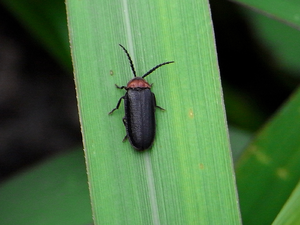
دورة الحياة
يحدث التزاوج بين الذكور والإناث في فصل الصيف ليلاً ثم تضع الأنثى البيض في التربة والذي يفقس بعد 4 أسابيع ثم يعطي عدة أطوار يرقية والتي تتغذى بافتراس الحشرات الصغيرة ثم تقضي فصلي الخريف والشتاء في بيات شتوي حيث تدفن نفسها في التربة وممكن أن تظل في بياتها لمدة سنتين ومع بداية الصيف تتغذى وتنشط وتتحول إلى طور العذراء وبعد ذلك تتحول إلى خنافس كاملة ذكور وإناث وتعيش الخنافس الكاملة من عدة أسابيع إلى شهرين حسب النوع.[13]
أهم أنواع الخنافس المضيئة والأكثر انتشارا في العالم
- Lampyris noctiluca :وتسمى الديدان المتوهجة (glow worms)وذلك لأن الإناث تشبه شكل الدودة وليس لها أجنحة ويبلغ طولها حوالي 10-25 مم. لونها بني داكن والحلقات الثلاث البطنية هي التي ينبعث منها الضوء لوجود الخلايا الضوئية بهم. الذكور مجنحة ولونها بني وأصغر حجمًا من الإناث وحواف الأجنحة الغمدية لونها أصفر وتتركز الخلايا المضيئة على الحلقة قبل الأخيرة للبطن.
- Photinus pyralis: وتسمى الخنافس الخاطفة طول الإناث حوالي 30مم والذكور أصغر حجمًا وكلا النوعين مجنح ولهما نفس الشكل حيث نجد أن الجسم لونه أسود داكن مع خطين لونهم أحمر على جانبي الرأس ونجد حواف الأجنحة الغمدية لونها بني كريمي. والخلايا الضوئية موجودة على الثلاث حلقات البطنية الأخيرة في كلا من الذكر والأنثى.
- Photurissp: وهى أصغر حجمًا من النوعين السابقين والذكور والإناث متشابهة في الشكل إلا أن الإناث أكبر حجما من الذكور ونجد أن لون الجسم بني مع وجود خطين لونهما أصفر على جانبي الرأس وعلى حواف الأجنحة الغمدية. وتنتشر الخلايا الضوئية على الحلقات الثلاث الأخيرة لكل من الذكور والأناث.
علاقتها بالإنسان
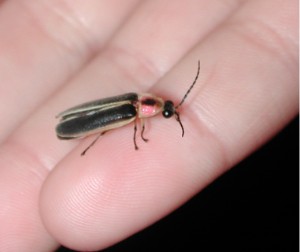
لقد كان اليراع جزءاً من الأساطير عن شعب المايا، حيث كان يربط بالنجوم. كما أنها أيضاً كانت تشبه بتدخين السجائر وربما يكون لها ممثل واحد على الأقل في مجموعة الآلهة ضمن آلهة المايا.
في شرق آسيا، يقوم الصينيون بإمساك اليراعات ووضعها في أوعية شفافة أو نصف شفافة حيث تستخدم على أنها قناديل.
المصادر
- ^ Cirrus Digit Firefly Photuris lucicrescens
- ^ أ ب Lewis, Sara (26 April 2016). Silent Sparks: The Wondrous World of Fireflies. Princeton University Press. p. 17. ISBN 978-1400880317.
- ^ أ ب ت Marshall, Michael (22 February 2020). "Why the lights are going out for fireflies". The Guardian. Retrieved 4 February 2022.
- ^ Fu, Xinhua; Nobuyoshi, Ohba; Vencl, Fredric V.; Lei, Chaoliang (2006). "Life cycle and behaviour of the aquatic firefly Luciola leii (Coleoptera: Lampyridae) from Mainland China". The Canadian Entomologist. 138 (6): 860–870. doi:10.4039/n05-093. S2CID 84624340.
- ^ Armstrong, Charles. "Winter Firefly". The University of Maine Cooperative Extension. Retrieved 22 June 2022.
- ^ "About Fireflies". Xerces Society for Invertebrate Conservation. Retrieved 22 June 2022.
- ^ McLean, Miriam; Buck, John; Hanson, Frank E. (1972). "Culture and Larval Behavior of Photurid Fireflies". The American Midland Naturalist. University of Notre Dame. 87 (1): 133–145. doi:10.2307/2423887. JSTOR 2423887.
- ^ Lau, T. F.; Meyer-Rochow, V. B. (2006). "Sexual dimorphism in the compound eye of Rhagophthalmus ohbai (Coleoptera: Rhagophthalmidae): Morphology and ultrastructure". Journal of Asia-Pacific Entomology. 9: 19–30. doi:10.1016/S1226-8615(08)60271-X.
- ^ Eisner, Thomas; Wiemer, David; Haynes, Leroy; Meinwald, Jerrold (1978). "Lucibufagins: Defensive steroids from the fireflies Photinus ignitus and P. marginellus (Coleoptera: Lampyridae)". PNAS. 75 (2): 905–908. Bibcode:1978PNAS...75..905E. doi:10.1073/pnas.75.2.905. PMC 411366. PMID 16592501.
- ^ Lewis, Sara M.; Cratsley, Christopher K. (January 2008). "Flash Signal Evolution, Mate Choice, and Predation in Fireflies". Annual Review of Entomology. 53 (1): 293–321. doi:10.1146/annurev.ento.53.103106.093346. PMID 17877452. S2CID 16360536.
- ^ Branham, Marc A.; Wenzel, John W. (December 2001). "The Evolution of Bioluminescence in Cantharoids (Coleoptera: Elateroidea)". The Florida Entomologist. 84 (4): 565. doi:10.2307/3496389. JSTOR 3496389.
- ^ Gullan & Cranston 2014, pp. 121–122.
- ^ http://insects.tamu.edu/fieldguide/bimg153.html
قراءات إضافية
- Branham, M. A.; Wenzel, J. W. (2003). "The origin of photic behavior and the evolution of sexual communication in fireflies (Coleoptera: Lampyridae)". Cladistics. 19 (1): 1–22. doi:10.1111/j.1096-0031.2003.tb00404.x.
- Lewis, S. M.; Cratsley, C. K. (2008). "Flash signal evolution, mate choice, and predation in fireflies". Annual Review of Entomology. 53: 293–321. doi:10.1146/annurev.ento.53.103106.093346.
- Stous, Hollend. "A review of predation in Photuris, and its effects on the evolution of flash signaling in other New World fireflies".
وصلات خارجية
- An introduction to European fireflies and glow-worms
- Firefly.org – Firefly & Lightning Bug Facts, Pictures, Information About Firefly Insect Disappearance
- Firefly simulating robot, China
- http://www.ncbi.nlm.nih.gov/Taxonomy/Browser/wwwtax.cgi
- Museum of Science, Boston – Understanding Fireflies
- Video of a firefly larva in Austria
- FireflyExperience.org – Luminous Photography and Videos of Fireflies & Lightning Bugs



